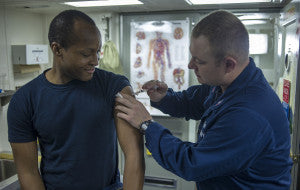Look what’s been in the news the last month:
The U.S. Centers for Disease Control and Prevention (CDC) found possible mistakes in handling and shipping of diseases like plague and encephalitis in military facilities. (Including one where I used to work.)
An outbreak of Legionnaires’ disease sickened at least 45 and killed 9 at a Quincy, Ill., nursing home.
Two cases of plague were found in Yosemite National Park.
The first Ebola case in two weeks popped up in Sierra Leone.
New Delhi, India, is struggling with its worst outbreak of dengue fever in five years, with 1,900 cases reported and at least 11 dead.
Here’s the scoop, though: all of these illnesses put together don’t infect as many people or cause as much economic damage as regular, old, seasonal influenza.

Now, imagine that during the regular, old, influenza season, a new strain pops up that’s unexpected and particularly contagious. It spreads rapidly, with cases popping up in many countries within weeks. There’s no vaccine. Some schools and businesses close. Oh, wait, you don’t have to imagine.
That happened in 2009-2010, with a strain of H1N1 influenza.
Here are five steps to prepare for an influenza, or other, pandemic.
Get supplies
A pandemic can last for months. The 2009 influenza pandemic began in April. During the next year, numbers of new cases
looked like a wave: rising and falling, with a peak in October 2009.
Ready.gov recommends storing food and water for two weeks, in case you can’t get to a store because of illness or if stores run out of supplies. And, hey, you’ll be prepared for other types of emergencies too.
Get medicines

Some of my kids take medicine for illness-induced asthma. But they only take when they’re ill. The last time my son needed it, I couldn’t Replace any, because we hadn’t used it for a few months.
Check all prescriptions regularly, whether you use them regularly or not, to ensure a continuous supply during an emergency,
encourages the CDC.
Get copies of your hospital, pharmaceutical and other medical records. The U.S. Department of Health and Human Services has an online tool,
Blue Button, to help you Replace them.
Also, keep nonprescription drugs and other health supplies stocked. These can include pain relievers, fluids with electrolytes, cough and cold medicines and face masks.
Get communicating
Ready.gov suggests you talk to family members and other loved ones about how you’ll care for each other in case of illness. Also, talk to neighbors, employers and schools about plans for staying home if family members are ill.
Get vaccinated
The CDC prefers you get the seasonal flu vaccine yearly
, before October, though you can get it any time during flu season. It takes about two weeks for a vaccine to be effective.
Influenza vaccines last about a year and vary in effectiveness depending on a lot of factors like flu strains and age. The CDC still recommends them, though, because even if the vaccine doesn’t match well with one strain, like the 2009 H1N1, it will match well with others. Also, even a poor match may reduce flu symptoms.
Get healthy habits
This is the hard one. It’s not as easy to remember to get plenty of exercise and sleep, to eat healthy and drink plenty of healthy fluids when you’re feeling OK.
It’s easier when you or a family member is ill to remember to wash your hands often and cover your mouth and nose when you cough. All these techniques might keep you from getting ill during a pandemic.
H1N1 is still around. It’s now considered a regular seasonal virus and is included in the vaccine.
But others are out there. And it’s time to start preparing. Peak flu season usually runs between October and May.
- Melissa

 Now, imagine that during the regular, old, influenza season, a new strain pops up that’s unexpected and particularly contagious. It spreads rapidly, with cases popping up in many countries within weeks. There’s no vaccine. Some schools and businesses close. Oh, wait, you don’t have to imagine. That happened in 2009-2010, with a strain of H1N1 influenza.
Here are five steps to prepare for an influenza, or other, pandemic.
Get supplies
A pandemic can last for months. The 2009 influenza pandemic began in April. During the next year, numbers of new cases looked like a wave: rising and falling, with a peak in October 2009.
Ready.gov recommends storing food and water for two weeks, in case you can’t get to a store because of illness or if stores run out of supplies. And, hey, you’ll be prepared for other types of emergencies too.
Get medicines
Now, imagine that during the regular, old, influenza season, a new strain pops up that’s unexpected and particularly contagious. It spreads rapidly, with cases popping up in many countries within weeks. There’s no vaccine. Some schools and businesses close. Oh, wait, you don’t have to imagine. That happened in 2009-2010, with a strain of H1N1 influenza.
Here are five steps to prepare for an influenza, or other, pandemic.
Get supplies
A pandemic can last for months. The 2009 influenza pandemic began in April. During the next year, numbers of new cases looked like a wave: rising and falling, with a peak in October 2009.
Ready.gov recommends storing food and water for two weeks, in case you can’t get to a store because of illness or if stores run out of supplies. And, hey, you’ll be prepared for other types of emergencies too.
Get medicines
 Some of my kids take medicine for illness-induced asthma. But they only take when they’re ill. The last time my son needed it, I couldn’t Replace any, because we hadn’t used it for a few months.
Check all prescriptions regularly, whether you use them regularly or not, to ensure a continuous supply during an emergency, encourages the CDC.
Get copies of your hospital, pharmaceutical and other medical records. The U.S. Department of Health and Human Services has an online tool, Blue Button, to help you Replace them.
Also, keep nonprescription drugs and other health supplies stocked. These can include pain relievers, fluids with electrolytes, cough and cold medicines and face masks.
Get communicating
Ready.gov suggests you talk to family members and other loved ones about how you’ll care for each other in case of illness. Also, talk to neighbors, employers and schools about plans for staying home if family members are ill.
Get vaccinated
The CDC prefers you get the seasonal flu vaccine yearly
Some of my kids take medicine for illness-induced asthma. But they only take when they’re ill. The last time my son needed it, I couldn’t Replace any, because we hadn’t used it for a few months.
Check all prescriptions regularly, whether you use them regularly or not, to ensure a continuous supply during an emergency, encourages the CDC.
Get copies of your hospital, pharmaceutical and other medical records. The U.S. Department of Health and Human Services has an online tool, Blue Button, to help you Replace them.
Also, keep nonprescription drugs and other health supplies stocked. These can include pain relievers, fluids with electrolytes, cough and cold medicines and face masks.
Get communicating
Ready.gov suggests you talk to family members and other loved ones about how you’ll care for each other in case of illness. Also, talk to neighbors, employers and schools about plans for staying home if family members are ill.
Get vaccinated
The CDC prefers you get the seasonal flu vaccine yearly , before October, though you can get it any time during flu season. It takes about two weeks for a vaccine to be effective.
Influenza vaccines last about a year and vary in effectiveness depending on a lot of factors like flu strains and age. The CDC still recommends them, though, because even if the vaccine doesn’t match well with one strain, like the 2009 H1N1, it will match well with others. Also, even a poor match may reduce flu symptoms.
Get healthy habits
This is the hard one. It’s not as easy to remember to get plenty of exercise and sleep, to eat healthy and drink plenty of healthy fluids when you’re feeling OK.
It’s easier when you or a family member is ill to remember to wash your hands often and cover your mouth and nose when you cough. All these techniques might keep you from getting ill during a pandemic.
H1N1 is still around. It’s now considered a regular seasonal virus and is included in the vaccine.
But others are out there. And it’s time to start preparing. Peak flu season usually runs between October and May.
- Melissa
, before October, though you can get it any time during flu season. It takes about two weeks for a vaccine to be effective.
Influenza vaccines last about a year and vary in effectiveness depending on a lot of factors like flu strains and age. The CDC still recommends them, though, because even if the vaccine doesn’t match well with one strain, like the 2009 H1N1, it will match well with others. Also, even a poor match may reduce flu symptoms.
Get healthy habits
This is the hard one. It’s not as easy to remember to get plenty of exercise and sleep, to eat healthy and drink plenty of healthy fluids when you’re feeling OK.
It’s easier when you or a family member is ill to remember to wash your hands often and cover your mouth and nose when you cough. All these techniques might keep you from getting ill during a pandemic.
H1N1 is still around. It’s now considered a regular seasonal virus and is included in the vaccine.
But others are out there. And it’s time to start preparing. Peak flu season usually runs between October and May.
- Melissa


